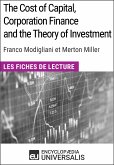Who is Merton Miller
An American economist by the name of Merton Howard Miller, he was a co-author of the Modigliani-Miller theorem (1958), which suggested that the debt-equity structure was irrelevant. William F. Sharpe and Harry Markowitz were the other two recipients of the Nobel Memorial Prize in Economic Sciences in 1990. He was one of the three recipients. Miller attended the Booth School of Business at the University of Chicago for the most of his time spent in the academic world.
How you will benefit
(I) Insights about the following:
Chapter 1: Merton Miller
Chapter 2: William Vickrey
Chapter 3: Financial economics
Chapter 4: Franco Modigliani
Chapter 5: Robert C. Merton
Chapter 6: Myron Scholes
Chapter 7: Modigliani-Miller theorem
Chapter 8: William F. Sharpe
Chapter 9: Harry Markowitz
Chapter 10: Capital structure
Chapter 11: David Dodd
Chapter 12: John Burr Williams
Chapter 13: Capital asset pricing model
Chapter 14: Jack L. Treynor
Chapter 15: Carnegie School
Chapter 16: Deutsche Bank Prize in Financial Economics
Chapter 17: Modern portfolio theory
Chapter 18: Financial innovation
Chapter 19: Xavier Gabaix
Chapter 20: Douglas Diamond
Chapter 21: Shareholder yield
Who this book is for
Professionals, undergraduate and graduate students, enthusiasts, hobbyists, and those who want to go beyond basic knowledge or information about Merton Miller.
An American economist by the name of Merton Howard Miller, he was a co-author of the Modigliani-Miller theorem (1958), which suggested that the debt-equity structure was irrelevant. William F. Sharpe and Harry Markowitz were the other two recipients of the Nobel Memorial Prize in Economic Sciences in 1990. He was one of the three recipients. Miller attended the Booth School of Business at the University of Chicago for the most of his time spent in the academic world.
How you will benefit
(I) Insights about the following:
Chapter 1: Merton Miller
Chapter 2: William Vickrey
Chapter 3: Financial economics
Chapter 4: Franco Modigliani
Chapter 5: Robert C. Merton
Chapter 6: Myron Scholes
Chapter 7: Modigliani-Miller theorem
Chapter 8: William F. Sharpe
Chapter 9: Harry Markowitz
Chapter 10: Capital structure
Chapter 11: David Dodd
Chapter 12: John Burr Williams
Chapter 13: Capital asset pricing model
Chapter 14: Jack L. Treynor
Chapter 15: Carnegie School
Chapter 16: Deutsche Bank Prize in Financial Economics
Chapter 17: Modern portfolio theory
Chapter 18: Financial innovation
Chapter 19: Xavier Gabaix
Chapter 20: Douglas Diamond
Chapter 21: Shareholder yield
Who this book is for
Professionals, undergraduate and graduate students, enthusiasts, hobbyists, and those who want to go beyond basic knowledge or information about Merton Miller.
Dieser Download kann aus rechtlichen Gründen nur mit Rechnungsadresse in A, B, BG, CY, CZ, D, DK, EW, E, FIN, F, GR, H, IRL, I, LT, L, LR, M, NL, PL, P, R, S, SLO, SK ausgeliefert werden.









